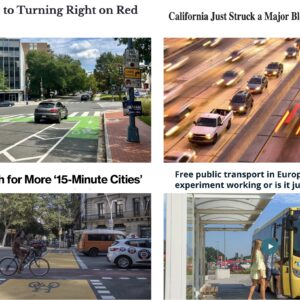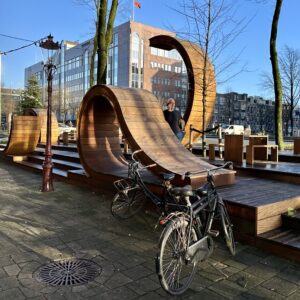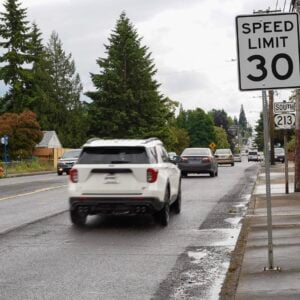From Cycleliciousness (the “Copenhagen Bicycle Culture Blog”), comes word of two interesting bike safety measures.
Given that we are in the midst of making some major bike safety improvements at dangerous intersections, I thought it might be useful to take a look at new technology being considered by the Danes.
The first is being tested in Copenhagen to reduce the number of right-hook collisions between bikes and trucks. It’s what the blog’s author calls, “a new system of diode lights” (similar the one in their photo at right) that would potentially reduce bike/car conflicts at dangerous intersections. Here’s more:
“Blinking diodes [similar to the photo above on a Copenhagen bike lane] are placed in the asphalt on the final stretch towards the intersection and, when a cyclist passes a sensor, the lights start to blink and warn motorists to the fact that a cycle is present.”
Imagine what these lights must look like at night!
The other technology is being tested in the Danish town of Grenaa. Also hoping to reduce right-hook collisions, Cycleliciousness tells us 300 bikes were installed with a tiny radio frequency infrared device identification (RFID) chip on the handlebars; “When the bikes approach an intersection, the RFID triggers a warning sign for cars and trucks.”
For a better sense of how this works, check out the animation below:
For more photos and information on the bike scene in Copenhagen, I highly recommend two blogs: Cycleliciousness and Copenhagen Girls on Bikes.







Thanks for reading.
BikePortland has served this community with independent community journalism since 2005. We rely on subscriptions from readers like you to survive. Your financial support is vital in keeping this valuable resource alive and well.
Please subscribe today to strengthen and expand our work.
Awesome.
The simplicity and beauty of the RFID triggered signal is stunning.
Yes. Awesome is a good word for it. I like it. Makes me want to move to Europe even more. I can, however, see privacy advocates having a field day with the use of RFID. \”They\” will know where you are, even when riding a bike… (unless, of course, they skip the ID part of RFID) 🙂 That said, I\’d put one on my bike.
\”The simplicity and beauty of the RFID triggered signal is stunning.\”
I agree encephalopath. Watching that animation I got chills and started thinking about the Tracey Sparling tragedy. I can only wonder, but if something like that was installed at that intersection, I bet she\’d be alive today.
Looks like you want to substitute \”Danish\” for \”Dutch\” in the title and text of the article.
Just saying.
(Speaking of which, we seem to have a Dutch bike mania in Portland these days. What about Danish bikes? Any notable differences?)
This looks like a great idea if it works for all bikes.
The problem I see with RFIDs is that some bikes would have them and some would not. What happens when drivers get use to the flashing lights and someone rides by on an old bike with no RFID? I could see this actually increasing right hooks if only most, but not all bikes trigger the lights.
Check out the Danish Rush Hour film on the Cycleliciousness web site. Notice how the bike lane is paired with a \”Bus only\” lane so there are no cars any where near the bikes. The overflow from the bike lanes then pass into the bus lane rather than having to pass into the traffic lane. This way busses have priority access through the city and would probably look out more for a bicyclist than other drivers.
interesting
These are band aid solutions meant to compensate for the poor design and placement of the bike lanes in the first place. We should be able to do it better, too bad so many bike advocates and planners in Portland drool over anything European when it comes to bike facilities, without considering whether or not it translates well to the US.
The lighted bike lane markers could be really nice to use along with the blue lanes in places of possible conflict (like the offramp on the East side of the Hawthorne Bridge). That could help out especially at night when those blue lanes might not be visible.
However, you\’d either want to make sure that the bike sensors a) detect all bikes and b) never break or just go without sensors and have the lights on all the time (just make sure the lights never go out). I\’d worry that if the electronics fail some motorists might not expect it and would run someone over.
BURR these are band-aid solutions until gas is $20/gal and we have shot most of the lawyers.
Hey you got the definition of RFID wrong. Infrared has nothing to do with the technology.
Radio Frequency IDentification (RFID)
BURR (#8) – this is true, but unfortunately we\’re stuck with band-aids in some locations because there isn\’t enough money available to correct them all. In many cases, a \”proper\” solution would be incredibly cost-prohibitive. I think you\’d agree that in those cases, anything that demonstratively increases safety is better than nothing.
If we were to implement these here, we\’d need orange lights, I think. Orange notifies drivers to be cautious – green would IMO only encourage them to disrespect the lane demarcation.
I\’d love the intersection protector, and if it had a triggering button at the curb edge, you wouldn\’t even need RFID.
Here specifically, you\’d want 2 buttons, one high, one low, so as not to discriminate against tallbikes. 😉
The privacy concerns over RFID could be alleviated with a generic \”bicycle\” tag instead of a coded tag being made for each individual. That would also be much cheaper as the tag could be mass produced for fractions of a cent rather than the dime each for the programmable versions. And the tag could be installed by making a large sticker to place on the bottom bracket or other convenient surface for a recumbent bicycle. [sigh] Another reason to discriminate against us \’Benters.
Opus
I laugh out LOUD when I saw this over at C-Liciousness. Just teach cyclists to move over to the MIDDLE of the lane, in front of traffic, where the truckers can see \’em.
More Rube Goldberg rocket science to needlessly coddle cyclists, like we are all BABIES. More high tech parens patria in ACTION.
I bet the C-hagen geniuses will really be surprised at the next right-hook. Another case of a pseudo-solution with way too MUCH engineering.
\” unfortunately we\’re stuck with band-aids in some locations because there isn\’t enough money available to correct them all. In many cases, a \”proper\” solution would be incredibly cost-prohibitive. I think you\’d agree that in those cases, anything that demonstratively increases safety is better than nothing\”
Right turns ought to be prohibited in the presence of bike lanes. This has demonstrably improved the safety of cyclists where it has been implemented and it would cost next to nothing money-wise.
Maybe I\’m a cynic, but I think the flashing bicyclist light will just serve to make people angrier when bystanders notice it flashing while resuscitating a dying bicyclist under the wheels of a truck. Hard to imagine a truck driver looking for one more warning sign when they don\’t even look at the ones we have now.
We can add as many techno-fixes as we want, but it takes a LOOOOONG time to retrain drivers to look for them. From the graphic, the truckers would have to know to look for the special flashing bike light AND know what it means in terms of their driving.
Suppose we could somehow get a comprehensive bicycle/car safety section in Oregon\’s drivers manual. This would still leave a huge awareness deficit for all of the out of state truckers, delivery people, commuters, and bridge n\’ tunnel weekend clubhoppers, not to mention people from rural Oregon who are not used to seeing bikes.
I\’ll have to side with the \”Use Common Sense\” crowd on this one and leave the onus of safe cycling on the biker, note the diode lights and infrared sensors.
-Ian
The best solution for road safety problems in the United States is a balance of terror. Motorists on public streets need to be as afraid of the consequences to themselves of injuring or killing someone with their heavy machinery as bystanders are of getting them by them — as any other heavy machinery operator would be in occupational settings where heavy machinery is used.
The real problem with a solution like the RFID idea is that it quickly becomes a standard. What happens when a cyclist is right hooked to death, and he did not have the RFID device? All of the sudden it becomes partially his fault, and a justification for the death. e.g. \”If he had one of those thingies, he would not have died.\”
BTW if you do not believe this argument, substitute \”helmet\” for \”thingy\” in the above sentence, and see how it plays. Things will not save us. Things only hamper the development on appropriate attitudes.
This is cool.
Maybe someday drivers will automatically get a ticket when passing to close to a bicycle. Now that would be super cool.
Oh and you could automatically issue speeding tickets. That could easily be done now, and the program could easily pay for itself. But, American drivers don\’t want safe roads. They want to do what they want, and they think driving a ginormous SUV is all the need to be safe.
Cøyøte, isn\’t that what we\’re supposed to do, give tools to people that help them navigate modern society? You argument doesn\’t make much sense to me. What if we substituted \”thingy\” for \”do not eat\” instructions on cans of Drano?
Logan 5 (#22), the cyclist is not doing anything wrong, or anything that should be construed as dangerous. However, the burden of using and maintaining of the RFID device is placed on the cyclist in order to compensate for a driver\’s lack of caution.
If you were to spill a can of Draino on the counter and not clean it up. Then your housemate made a sandwich on the counter and got sick, would it be his fault for not reading the can? Should he have a Draino detector? What if he knew you were using Draino earlier?
I would say no. You were the Draino user (driver) and it was your responsibility to make sure you used it properly. The fact that he knew you were using Draino and that pH detectors are common is not relevant. You have the responsibility to be a reasonable housemate (driver).
Now let\’s say you make soap and use Draino frequently. In order to protect you and your housemate you get a pH meter so any suspect material can be tested. He tells you that this is fine, but you have to do the testing. You tell him that you will show him how to use the meter. He tels you that he does not want to use the meter he is just making a sandwich.
The burden is still on you. It is unacceptable to use Draino in a irresponsible way. Similarly, it is unacceptable drive in an irresponsible way. In this case, to make a right turn without looking.
If you impose the responsibility of tripping the signal on the cyclist and the RFID use becomes prevalent. The danger is that it will become a standard of care required to use a bicycle safely in the city. Cyclists who do not use the device may be held at least partially responsible for the crash.
One of the main gripes that I have with the plentiful traffic signals that we are all supposed to obey universally is that mnost of them were not designed with bikes in mind, nor do they even acknowledge the existence, much less the presence, of a bicyclist. In many cases, I feel that, if I do not exist in their lexicon, they do not need to exist in mine. This is a traffic control device that would be specifically designed to acknowledge and serve bicyclists. As traffic control devices go, that makes it just fine in my book. Of course, it will only be as reliable as any traffic control device, but it can only be a step in the right direction.
If we\’re going to put up a light, how about simply a \”no right turn when flashing\” light that kicks in whenever bikes trip the existing bike lane sensor? That would take care of the right-cross. Now if only we could do something similar for the left cross…
I agree with #25. why go space age when we already have a system that senses bikes. We just need a sensor at every intersection. We could have bike sign that light up at intersections like the light up max signs. Use technology we already have first.
This is terrible! RFID tags actually used to track where you are physically located!
How funny that that is the exact fear that privacy rights advocates have with the use of RFID tags used as a replacement of debit cards to purchase goods.